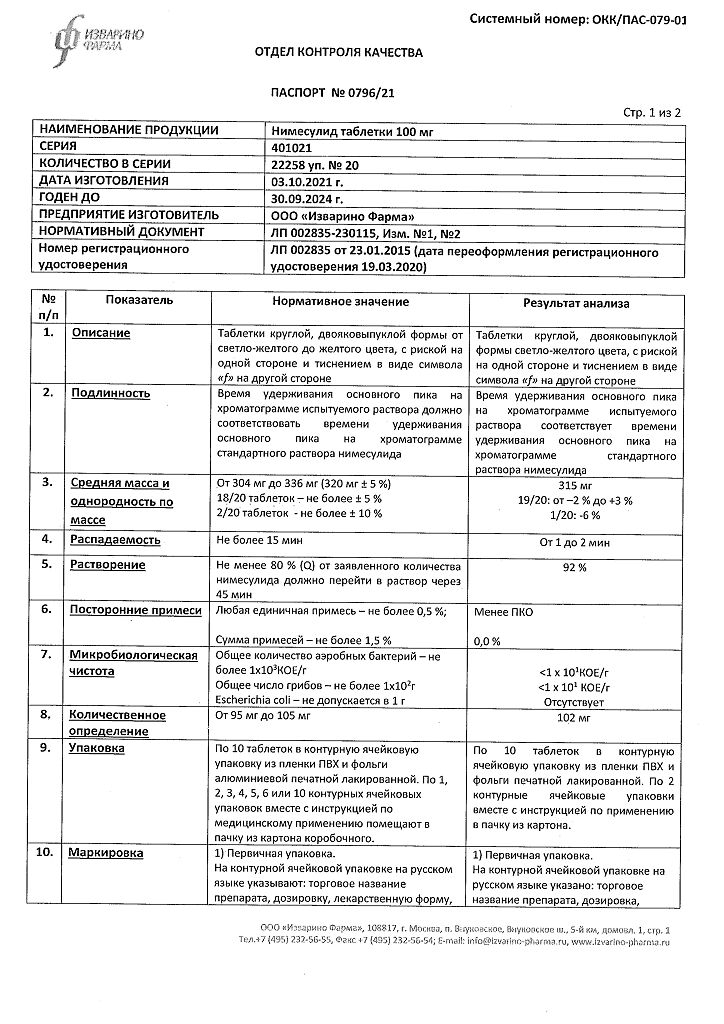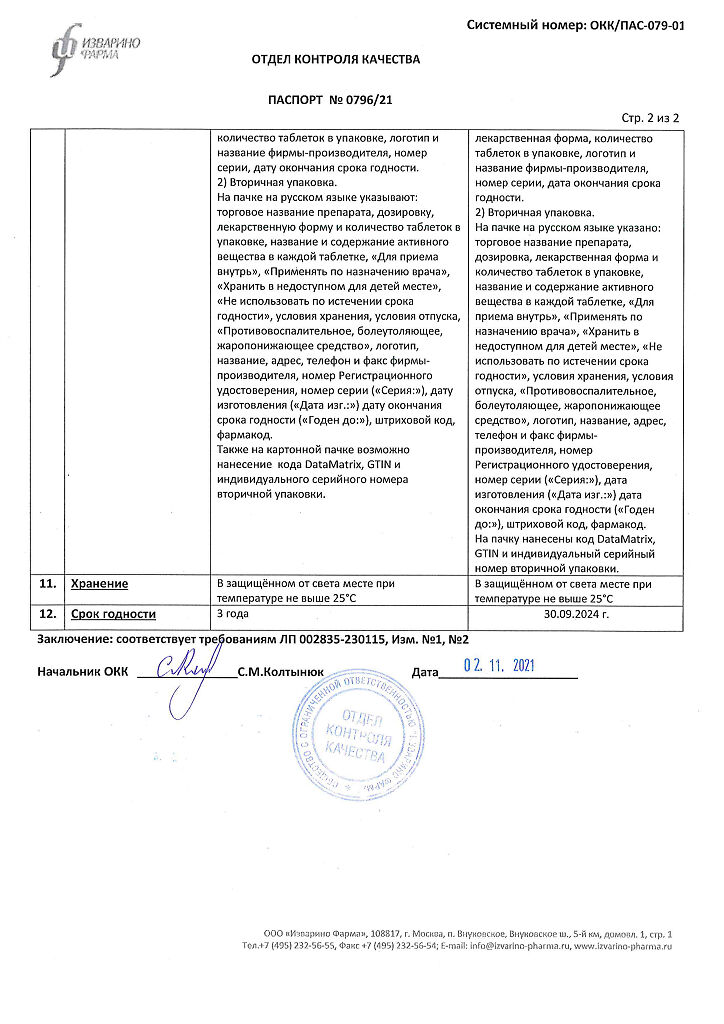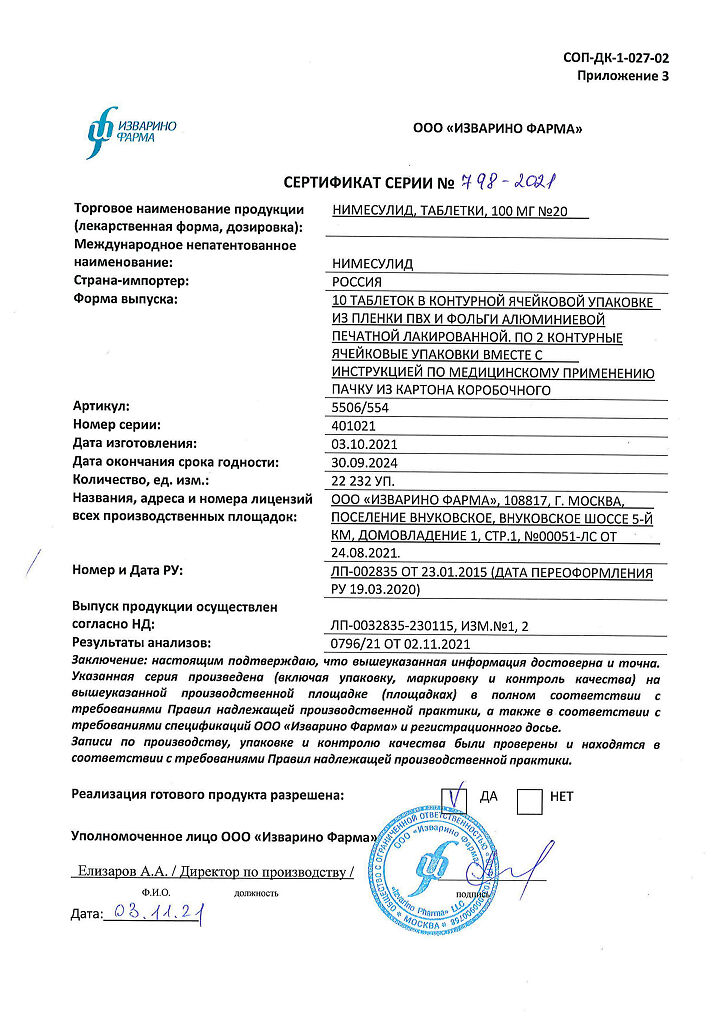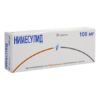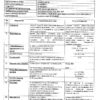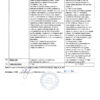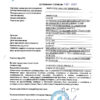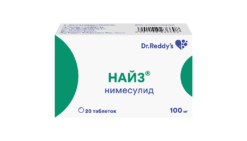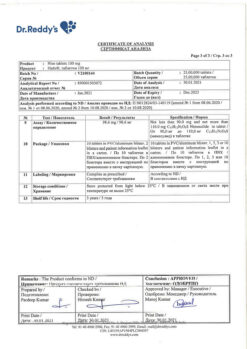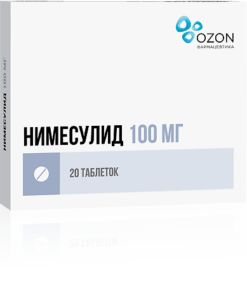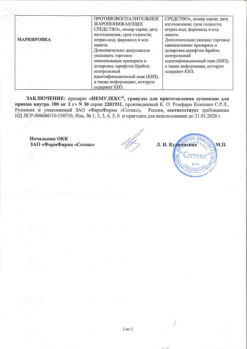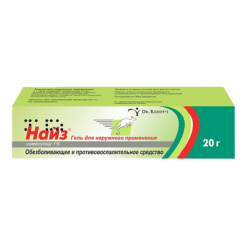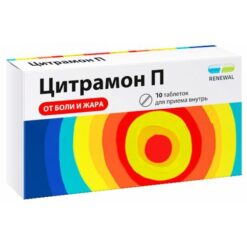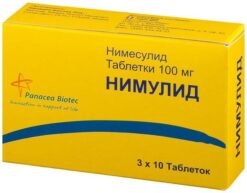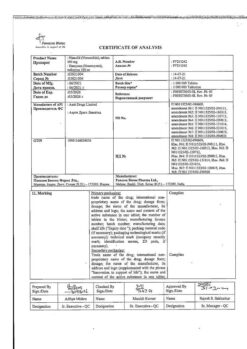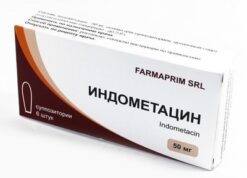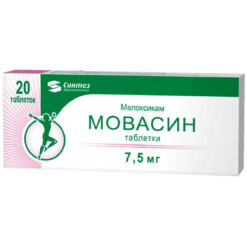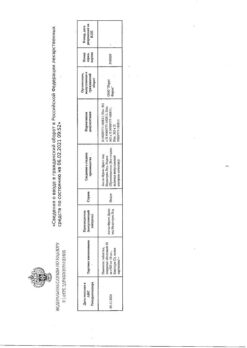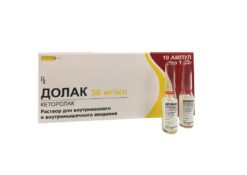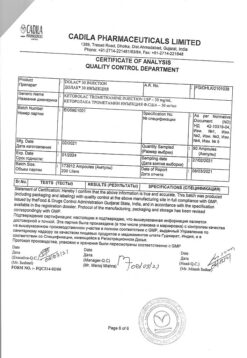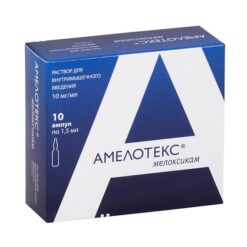No products in the cart.
Nimesulide, tablets 100 mg 20 pcs
€9.45 €7.87
Description
Non-steroidal anti-inflammatory drugs (NSAIDs)
ATX code: M01AX17
Pharmacodynamics
Nimesulide is a non-steroidal anti-inflammatory drug of sulfonamide class. It has anti-inflammatory, analgesic and antipyretic effect. Unlike non-selective NSAIDs, nimesulide mainly inhibits cyclooxygenase-2 (COX-2), inhibits synthesis of prostaglandins in inflammation focus, has less pronounced inhibitory effect on cyclooxygenase-1 (COX-1).
Pharmacokinetics
Nimesulide is well absorbed from the gastrointestinal tract (GIT)
Maximal concentration in blood plasma (Stah) after oral administration of a single dose of nimesulide, 100 mg, is reached on average after 2-3 hours and is 3-4 mg/l. The area under the curve “concentration-time” (AUC) is 20-35 mg/hl.
Binding with blood plasma proteins is up to 97.5%.
Metabolized in the liver by cytochrome Р450 isoenzyme (CYP)2C9. The main metabolite is pharmacologically active parahydroxy derivative of nimesulide – hydroxynimesulide, which is found exclusively as glucuronate.
Nimesulide is excreted mainly with urine (about 50% of the dose taken), about 29% is metabolized with feces.
The half-life (T1/2) is 3.2-6 hours.
Pharmacokinetic profile of nimesulide in elderly patients and in patients with renal insufficiency of mild and moderate severity is not changed when using single and multiple/repeated doses.
In a study conducted in patients with mild to moderate renal insufficiency (creatinine clearance 30-80 ml/min), the rates of nimesulide and its main metabolite were not higher than in healthy volunteers. AUC and Tj/2 were 50% higher, but were within the values of AUC and Tj/2 observed in healthy volunteers on nimesulide.
Repeated use did not lead to nimesulide cumulation.
.
Indications
Indications
– acute pain (pain in the back, lower back; pain in the musculoskeletal system, including bruises, sprains and dislocations of joints; tendinitis, bursitis; toothache);
– symptomatic treatment of osteoarthritis (osteoarthritis) with pain syndrome;
– primary algodismenorrhea.
The drug is intended for symptomatic therapy, reducing pain and inflammation at the time of use; nimesulide is recommended for therapy as a second-line drug.
Pharmacological effect
Pharmacological effect
Nonsteroidal anti-inflammatory drugs (NSAIDs)
ATX code: M01AX17
Pharmacodynamics
Nimesulide is a non-steroidal anti-inflammatory drug from the sulfonamide class. It has anti-inflammatory, analgesic and antipyretic effects. Unlike non-selective NSAIDs, nimesulide mainly inhibits cyclooxygenase-2 (COX-2), inhibits the synthesis of prostaglandins at the site of inflammation; has a less pronounced inhibitory effect on cyclooxygenase-1 (COX-1).
Pharmacokinetics
Nimesulide is well absorbed from the gastrointestinal tract (GIT)
The maximum concentration in blood plasma (Cmax) after oral administration of a single dose of nimesulide, amounting to 100 mg, is achieved on average after 2-3 hours and is 3-4 mg/l. Area under the concentration-time curve (AUC) – 20-35 mg h/l.
Connection with blood plasma proteins – up to 97.5%.
Metabolized in the liver using the cytochrome P450 (CYP)2C9 isoenzyme. The main metabolite is the pharmacologically active parahydroxy derivative of nimesulide – hydroxynimesulide, which is found exclusively in the form of glucuronate.
Nimesulide is excreted from the body mainly in the urine (about 50% of the dose taken); in metabolized form, about 29% is excreted in feces.
The half-life (T1/2) is 3.2-6 hours.
The pharmacokinetic profile of nimesulide in elderly people and in patients with mild to moderate renal failure does not change when using single and multiple/repeated doses.
In a study conducted in patients with mild to moderate renal failure (creatinine clearance 30-80 ml/min), Cmax of nimesulide and its main metabolite were no higher than in healthy volunteers. AUC and T1/2 were 50% higher, but were within the range of AUC and Tj/2 values observed in healthy volunteers when using nimesulide.
Repeated use did not lead to the accumulation of nimesulide.
Special instructions
Special instructions
Undesirable side effects can be minimized by using the drug in the minimum effective dose with the minimum duration of use necessary to relieve pain.
There is evidence of very rare cases of serious reactions from the liver, including cases of death, associated with the use of nimesulide-containing drugs. If symptoms similar to signs of liver damage appear (anorexia, itching, yellowing of the skin, nausea, vomiting, abdominal pain, dark urine, increased activity of liver transaminases), you should immediately stop using the drug Nimesulide and consult a doctor. Repeated use of the drug
Nimesulide is contraindicated in such patients.
Liver reactions, which are in most cases reversible, have been reported with short-term use of the drug.
While using the drug Nimesulide, the patient should refrain from taking other analgesics, including NSAIDs (including selective COX-2 inhibitors).
The drug Nimesulide should be used with caution in patients with a history of gastrointestinal diseases (ulcerative colitis, Crohn’s disease), since exacerbation of these diseases is possible.
The risk of gastrointestinal bleeding, peptic ulcer/perforation of the stomach or duodenum increases in patients with a history of ulcerative lesions of the gastrointestinal tract (ulcerative colitis, Crohn’s disease), as well as in elderly patients, with increasing doses of NSAIDs, so treatment should be started with the lowest possible dose.
In such patients, as well as in patients who require the simultaneous use of low doses of acetylsalicylic acid or other drugs that increase the risk of complications from the gastrointestinal tract, it is recommended to additionally prescribe gastroprotectors (misoprostol or proton pump blockers).
Patients with a history of GI disease, especially older patients, should report new GI symptoms (especially symptoms that may indicate possible GI bleeding) to their physician.
Nimesulide should be administered with caution to patients taking drugs that increase the risk of ulceration or bleeding (oral corticosteroids, anticoagulants such as warfarin, selective serotonin reuptake inhibitors or antiplatelet agents such as acetylsalicylic acid).
If gastrointestinal bleeding or gastrointestinal ulceration occurs in patients taking Nimesulide, treatment with the drug must be stopped immediately.
Given reports of visual impairment in patients taking other NSAIDs, if any visual impairment occurs, use of Nimesulide should be immediately discontinued and an ophthalmological examination performed.
The drug may cause fluid retention, therefore, in patients with arterial hypertension, renal and/or heart failure, Nimesulide should be used with extreme caution. If the condition worsens, treatment with Nimesulide should be stopped.
Clinical studies and epidemiological data suggest that NSAIDs, especially at high doses and with long-term use, may lead to a small risk of myocardial infarction or stroke. There is insufficient data to exclude the risk of such events when using nimesulide.
The drug may cause fluid retention in the body.
In patients with arterial hypertension, renal and/or heart failure, coronary heart disease, peripheral arterial disease and/or cerebrovascular diseases, with risk factors for the development of cardiovascular diseases (for example, hyperlipidemia, diabetes mellitus, smokers), Nimesulide should be used with extreme caution. If the condition worsens, treatment with Nimesulide should be stopped.
The drug contains lactose monohydrate (milk sugar), this should be taken into account by patients suffering from diabetes mellitus (0.14-0.16 XE per 100 mg of the drug) and those on a low-calorie diet; Nimesulide is not recommended for use in patients with lactose intolerance, lactase deficiency or glucose-galactose malabsorption syndrome.
If signs of a “cold” or acute respiratory infection occur; viral infection during the use of the drug Nimesulide, the drug should be discontinued.
Nimesulide can change the properties of platelets, so caution must be exercised when using the drug in people with hemorrhagic diathesis, however, the drug does not replace the preventive effect of acetylsalicylic acid in cardiovascular diseases.
Elderly patients are particularly susceptible to adverse reactions to NSAIDs, including the risk of life-threatening gastrointestinal bleeding and perforation, and decreased renal, hepatic, and cardiac function. When taking the drug Nimesulide for this category of patients, proper clinical monitoring is necessary.
There is evidence of the occurrence in rare cases of skin reactions (such as exfoliative dermatitis, Stevens-Johnson syndrome, toxic epidermal necrolysis) when taking NSAIDs, including nimesulide. At the first manifestations of a skin rash, damage to the mucous membranes or other signs of an allergic reaction, Nimesulide should be stopped immediately.
Active ingredient
Active ingredient
Nimesulide
Composition
Composition
1 package contains:
active substance:
nimesulide – 100 mg;
excipients:
povidone K-30 (medium molecular weight polyvinylpyrrolidone) – 35.0 mg;
lactose monohydrate (milk sugar) – 1663.0 mg;
crospovidone (Kollidon CL-M) – 120.0 mg;
aspartame – 10.0 mg;
citric acid monohydrate – 30.0 mg;
orange flavor – 42.0 mg.
Pregnancy
Pregnancy
Like other drugs from the class of NSAIDs that inhibit the synthesis of prostaglandins, nimesulide can adversely affect the course of pregnancy and/or the development of the embryo and can lead to premature closure of the ductus arteriosus, hypertension in the fetal pulmonary artery system, impaired renal function, which can progress to renal failure with oliguria in the fetus, an increased risk of bleeding, decreased contractility of the uterus, and the occurrence of peripheral edema in the mother.
Data obtained from epidemiological studies indicate a possible increase in the risk of spontaneous abortion, the risk of heart disease and gastroschisis when using drugs that block prostaglandin synthesis in early pregnancy.
The absolute risk of developing a cardiovascular abnormality increases from approximately 1% to 1.5%. The risk is believed to increase with increasing dose and duration of use.
There is no data on the penetration of nimesulide into breast milk.
The use of Nimesulide during pregnancy and breastfeeding is contraindicated.
The use of nimesulide may adversely affect female fertility and is not recommended for women planning pregnancy.
When planning a pregnancy, consultation with your doctor is necessary.
Contraindications
Contraindications
– hypersensitivity to nimesulide or other components of the drug;
– history of hyperergic reactions (bronchospasm, rhinitis, urticaria) associated with the use of acetylsalicylic acid or other NSAIDs, including nimesulide;
– complete or incomplete combination of bronchial asthma, recurrent polyposis of the nose or paranasal sinuses with intolerance to acetylsalicylic acid and other NSAIDs (including a history);
– history of hepatotoxic reactions to nimesulide;
– simultaneous use with other drugs with potential hepatotoxicity (for example, other NSAIDs);
– chronic inflammatory bowel diseases (Crohn’s disease, ulcerative colitis) in the acute phase;
– period after coronary artery bypass grafting;
– febrile syndrome with colds and acute respiratory viral infections;
– suspicion of acute surgical pathology;
– peptic ulcer of the stomach or duodenum in the acute phase; erosive and ulcerative lesions of the gastrointestinal tract; history of perforation or gastrointestinal bleeding;
– a history of cerebrovascular bleeding or other diseases accompanied by increased bleeding;
-severe blood clotting disorders;
– severe heart failure;
– severe renal failure (creatinine clearance < 30 ml/min), confirmed hyperkalemia;– liver failure or any active liver disease;– children’s age up to 12 years;– pregnancy and breastfeeding period;– alcoholism, drug addiction;– hereditary lactose intolerance, lactase deficiency or glucose-galactose malabsorption syndrome.With cautionArterial hypertension, diabetes mellitus, compensated heart failure, coronary heart disease, cerebrovascular diseases, dyslipidemia/hyperlipidemia, peripheral arterial diseases, hemorrhagic diathesis, smoking, creatinine clearance 30-60 ml/min.History of ulcerative lesions of the gastrointestinal tract; history of infection caused by Helicobacter pylori; old age; long-term previous use of NSAIDs; severe somatic diseases.Concomitant use with the following drugs: anticoagulants (for example, warfarin), antiplatelet agents (for example, acetylsalicylic acid, clopidogrel), oral glucocorticosteroids (for example, prednisolone), selective serotonin reuptake inhibitors (for example, citalopram, fluoxetine, paroxetine, sertraline).
Side Effects
Side Effects
The frequency is classified according to the recommendations of the World Health Organization, depending on the occurrence of the case: very often (> 1/10), often (> 1/100, 1/1000, 1/10000, < 1/1000), very rarely (< 1/10000), including
separate messages.
Disorders of the blood and lymphatic system: rarely – anemia, eosinophilia, hemorrhage; very rarely – thrombocytopenia, pancytopenia, thrombocytopenia purpura cheskaya.
Immune system disorders: rarely – hypersensitivity reactions; very rarely – anaphylactoid reactions.
Disorders of the skin and subcutaneous tissues: infrequently – itching, skin rash, increased sweating; rarely – dermatitis; very rarely – urticaria, angioedema, facial edema, erythema multiforme, Stevens-Johnson syndrome, toxic epidermal necrolysis (Lyell’s syndrome).
Nervous system disorders: infrequently – dizziness; very rarely – headache, drowsiness, encephalopathy (Reye’s syndrome).
Mental disorders: rarely – a feeling of fear, nervousness, nightly “nightmare” dreams.
Visual disturbances: rarely – blurred vision. very rarely – visual impairment.
Hearing and labyrinthine disorders: very rarely – vertigo.
Disorders of the cardiovascular system: infrequently – increased blood pressure; rarely – tachycardia, lability of blood pressure, “flushes” of blood to the skin of the face, palpitations.
Respiratory system disorders: infrequently – shortness of breath; very rarely – exacerbation of bronchial asthma, bronchospasm.
Gastrointestinal disorders: often – diarrhea, nausea, vomiting; uncommon – constipation, flatulence, gastritis, gastrointestinal bleeding, ulcer and/or perforation of the stomach or duodenum; very rarely – abdominal pain, dyspepsia, stomatitis, tarry stools.
Disorders of the liver and biliary tract: often – increased activity of liver enzymes; very rarely – hepatitis, fulminant hepatitis (including deaths), jaundice, cholestasis.
Renal and urinary tract disorders: rarely – dysuria, hematuria, urinary retention; very rarely – renal failure, oliguria, interstitial
jade.
Disorders of water and electrolyte metabolism: rarely – hyperkalemia.
Other: infrequently – peripheral edema; rarely – malaise, asthenia; very rarely – hypothermia.
Interaction
Interaction
Corticosteroids increase the risk of gastrointestinal ulcers or bleeding.
Antiplatelet agents and selective serotonin reuptake inhibitors (SSRIs), such as fluoxetine, increase the risk
occurrence of gastrointestinal bleeding.
NSAIDs may enhance the effect of anticoagulants such as warfarin. Due to the increased risk of bleeding, this combination is not recommended and is contraindicated in patients with severe coagulation disorders. If combination therapy cannot be avoided, careful monitoring of blood clotting parameters is necessary.
Diuretics:
NSAIDs may reduce the effect of diuretics.
In healthy volunteers, nimesulide temporarily reduces the excretion of sodium under the influence of furosemide, to a lesser extent the excretion of potassium, and reduces the actual diuretic effect.
The simultaneous use of nimesulide and furosemide leads to a decrease (by approximately 20%) in the area under the concentration-time curve (AUC) and a decrease in the cumulative excretion of furosemide without changing the renal clearance of furosemide.
The simultaneous use of furosemide and nimesulide requires caution in patients with renal or heart failure.
ACE inhibitors and angiotensin-P receptor antagonists:
NSAIDs may reduce the effect of antihypertensive drugs. In patients with mild to moderate renal failure (creatinine clearance 30-80 ml/min), with simultaneous use of ACE inhibitors, angiotensin II receptor antagonists and drugs that suppress the cyclooxygenase system (NSAIDs, antiplatelet agents), further deterioration of renal function and the occurrence of acute renal failure, which is usually reversible, is possible. These interactions should be considered in patients taking nimesulide in combination with ACE inhibitors or angiotensin II receptor antagonists. Therefore, the simultaneous use of these drugs should be done with caution, especially in elderly patients.
Patients should remain adequately hydrated and renal function should be closely monitored after concomitant use is initiated.
Mifepristone
Theoretically, it is possible to reduce the effectiveness of mifepristone and prostaglandin analogues when used simultaneously with NSAIDs (including acetylsalicylic acid) due to the antiprostaglandin action of the latter. Limited data indicate that use of an NSAID on the same day as a prostaglandin analogue does not adversely affect the effects of mifepristone or a prostaglandin analogue on cervical dilatation, uterine contractility, or reduce the clinical effectiveness of medical abortion.
There is evidence that NSAIDs reduce the clearance of lithium, which leads to increased plasma lithium concentrations and its toxicity. When using nimesulide in patients undergoing lithium therapy, the concentration of lithium in the blood plasma should be regularly monitored.
Clinically significant interactions with glibenclamide, theophylline, igoxin, cimetidine and antacids (eg,
combination of aluminum and magnesium hydroxides) was not observed.
Nimesulide inhibits the activity of the CYP2C9 isoenzyme. When taking drugs that are substrates of this enzyme with nimesulide, the concentration of the latter in plasma may increase.
When prescribing nimesulide less than 24 hours before or after using methotrexate, caution is required, since in such cases the concentration of methotrexate in the blood plasma and, accordingly, toxic effects may increase.
Due to their effect on renal prostaglandins, inhibitors of prostaglandin synthetase, such as nimesulide, may increase the nephrotoxicity of cyclosporines.
Overdose
Overdose
Symptoms: apathy, drowsiness, nausea, vomiting, pain in the epigastric region. These symptoms are usually reversible with symptomatic and supportive therapy. Possible increased blood pressure, gastrointestinal bleeding, acute renal failure, respiratory depression, coma, anaphylactoid reactions.
Treatment: Symptomatic and supportive therapy. There is no specific antidote. If an overdose has occurred within the last 4 hours, it is necessary to induce vomiting and/or take activated carbon (60 to 100 g for an adult) and/or an osmotic laxative. Forced diuresis, hemodialysis, hemoperfusion, and urine alkalization are ineffective due to the high degree of binding of nimesulide to blood plasma proteins (up to 97.5%). It is necessary to monitor the state of kidney and liver function.
Storage conditions
Storage conditions
In a place protected from light, at a temperature not exceeding 25 °C.
Keep out of the reach of children.
Shelf life
Shelf life
3 years. Do not use after the expiration date stated on the package.
Manufacturer
Manufacturer
Izvarino Pharma, Russia
Additional information
| Shelf life | 3 years. Do not use after the expiration date printed on the package. |
|---|---|
| Conditions of storage | In the light-protected place at a temperature not exceeding 25 OS. Keep out of reach of children. |
| Manufacturer | Izvarino Pharma, Russia |
| Medication form | pills |
| Brand | Izvarino Pharma |
Other forms…
Related products
Buy Nimesulide, tablets 100 mg 20 pcs with delivery to USA, UK, Europe and over 120 other countries.


